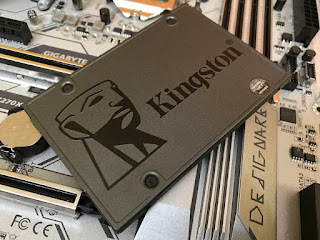Kingston is brand that needs no introduction when it comes to storage devices or RAM modules. Known for its high price to performance ratio the brand specializes in budget oriented devices. Recently we'd had a look at their UV400 which is aimed at the budget segment and were impressed by what it was offering for the price but at CES this year Kingston launched the successor to the UV400 in form of the Kingston A400 SSD.
Thanks to Kingston India today we have with us today the Kingston A400 240GB SSD for review, so without wasting any time lets quickly get to its specifications.
Kingston opted for an entirely new controller this time in form of the Phison PS3111-S11 which is a dual channel controller and relatively new to the conventional controllers already in use. The choice is obviously indicating more towards cost cutting which we'll be discussing later on in the review.
Coming in at capacities of 120GB, 240GB and 480GB the SSDs are flat out rated at 500MB/s read speed and varying write speeds. Our 240GB sample is rated at 500MB/s read and 350MB/s write speeds and comes with a price tag of $84 or Rs 6000 in India which is identical to that of the Kingston UV400.
Packing and Closer Look
Kingston brings the A400 in a clear blister pack with the capacity and 3 Years Warranty support clearly listed and boldly printed for the buyers to know. A point worth noticing is that its not a SSDNow offering which marks the entry level SSDs from Kingston but is a standalone product this time. They've also made sure that you come to know that the drive is ten times faster than a mechanical HDD just to keep the marketing part up!
The back side has the brief description in multiple languages along with the importer sticker and price neatly printed. There is also a slit through which you can actually touch and read the sticker stuck behind the actual SSD itself.
Inside you get just the A400 SSD and nothing else like a bracket or spacer as its a budget drive and these measures are necessary to keep the price in check.
Looking at the SSD itself we see that its a grey colored device with a crisp and embossed Kingston branding. The drive is 7mm thick and weighs in at ~41g which is around 16g lighter than the SSDNow UV400.
The back is clean with a sticker enlisting the serial number, model number, capacity and the various quality check logos.
A thing worth mentioning is that even though the A400 is a budget drive its still made out of a textured aluminum casing with slight roughness to it which to be honest many other manufacturers resist using even in their premium SATA drives! Probably this is the best looking and rather most elegant SSD we've come across so far. Its simple & sophisticated all over.
Open the case, it'll void the warranty, to see the full size PCB housing 8 NAND chips & a controller. Kingston has used Toshiba 2D Planar 15nm TLC NAND and each of them are 30GB in size to provide the full 240GB. You'll notice that there is no DRAM buffer on this PCB, this we'll be discussing in the next section!
The controller used is a Phison PS3111-S11 dual channel chip which is aimed at powering DRAM less solutions such as the A400 hence achieving lower production cost and super low power consumption. S11 is Phison's first controller to support LDPC (Low Density Parity Correction) error correction. How this "interesting" offering fairs off against other controller based SSDs? For that we'll have to put it to test in our benchmarking section.
Test Setup and Benchmarks
We used our usual testbench to benchmark the Kingston A400 240GB SATA SSD.CPU: Intel Core i7 7700K 4.2Ghz
Motherboard: Gigabyte Z270X Designare
RAM: Kingston HyperX Predator 8GB DDR4 3000Mhz Memory Kit
Cooler: Corsair H100i GTX (Push Pull Configuration)
Graphics Card: Gigabyte GTX 1050 Ti G1 Gaming 4GB OC
Storage: Kingston A400 240GB SSD
Power Supply: Corsair AX860i 860W 80+ Platinum
OS: Windows 8.1 Pro 64-bit
The drive was easy to fit in and installed without a problem. Following our usual SSD testing methods we formatted the drive and put it as a secondary drive with our main SSD loaded with Windows 8.1 Pro 64-bit. The entire test suite was run twice to obtain the best possible reading, each session performed after a fresh system restart. Out of the 240GB promised only 223GB on this drive is usable so around 7% of the total space is reserved for memory buffer.
For the benchmarks we'll be pitting the Kingston A400 240GB against Kingston's own UV400 480GB and ADATA XPG SX930 240GB SSDs. While one is a similar priced offering the other is an older but a high end SSD from a competing brand.
TRIM Check
Since this is a very new SSD for us so it called for some new testing suits aswell, one such tool is TrimCheck which verifies if TRIM function on the drive is working perfectly or not.The test shows that TRIM is perfectly working on the Kingston A400 SSD.
Crystal Disk Info V7.0.5
Crystal Disk Info is a great tool for displaying the characteristics and health of storage devices. It displays everything from temperatures, to the number of hours the device has been powered, and even to the extent of informing you of the firmware of the device.Crystal Disk Info shows us that a bunch of useful SMART attributes are presented to the end user. Total reads and writes as well as NAND writes are shown. The firmware version we are testing with today is version SBFK10D7 with the drive working at optimum temperatures even during summers.
ATTO Disk
ATTO Disk Benchmark measures transfer rates across specific lengths for any storage system. ATTO uses RAW data, I set my transfer size from 0.5 to 8192kb. This is generally the most reliable benchmarks for today's SSDs.Its clear aswell as surprising that the Kingston A400 with its new Phison controller is zooming against the competition! I was definitely not expecting such high grade performance from a new dual channel controller which has no DRAM buffer!
Also these speeds are way more than what Kingston has advertised for the A400 SSD. Kingston you are one humble lad eh?
CrystalDiskMark 5.0.2
CrystalDiskMark is a disk benchmark software that analyses different types of hard drive. Giving sequential benchmark write and read statistics in MB/s. A simple program that is very useful.A similar scenario can be seen here aswell with a noticeable factor that even though its a DRAM less SSD the A400 has over 42MB/s of read and over 96MB/s of write speed in the 4K spectrum which is way higher than most of the more expensive SSDs that have quad or even eight channel controller with huge DRAM buffers!
Anvil Storage Utility
The next test is Anvil Storage Utilities, which is a really great piece of software. The SSD benchmark gives you scores for both read and write as well as a combined score.While the A400 is an overall winner by a significant margin over the UV400 it does tie the score with the SX930 which is yet again a feat for the Kingston A400.
Also in the IOPS test the A400 is better than the UV400 in the write test while beats the SX930 in the read test showing that the drive is extremely competent!
AS SSD
The AS SSD software determines the performance of Solid State Drives (SSD). The tool contains five synthetic and three practice tests. The synthetic tests determine the sequential and random read and write performance of the SSD. These tests are performed without using the operating system caches. In Sequential tests, the program measures the time it takes to read and write a 1 GB file respectively.AIDA64 Extreme Edition v5.60
AIDA64 is one of the best tools out there to check the system stability, error diagnostics and even to validate overclocking.It has a set of suites for almost every hardware out there including SSD/HDD. So we started of with AIDA64 disk suites.
As we can see that the drive is hitting the advertised speeds and is extremely consistent in read and write activities. This is a very good indications since most drives including the UV400 tend to fluctuate a lot in the Linear and Random Read tests indicating towards a more solid and consistent performance by the A400
HD Tune Pro
HD Tune Pro is one of the most popular hard drive software suites available. It has many different benchmarks and tests built into it. Our first test is the read benchmark, which tests the average read speed and access time of the drive.It was necessary to use it even after so many tests just to give all of you a graph of how constant the speed is on this SSD as many SSDs tend to fluctuate on the read/write speed which ultimately gives you unstable performance.
A brilliant performance presented by the A400 yet again where its beating the competition by substantial margin! The drive is not only extremely consistent but shows really high speeds.
PCMark Vantage
We used the PCMark Vantage HDD test which is one of the best range of test suits out there for measuring the performance of any HDD/SSD. Tests are conducted by simulating real life tasks such as Windows Start up, Gaming etc.With an overall score of 86807 and lowest speed of 305MB/s in the 'adding music to Windows Media Player' test the Kingston A400 has surpasses every competition in its segment and beyond! Even SSDs with quad-channel or octa-channel controllers have failed to put a score this high, this Phison S11 controller has some limitless potential. To be precise these are the highest score we've seen on any SATA SSD till date!
PCMark 8 Professional Edition
PCMark 8 Storage Test unlike PCMark Vantage scores and records the SSD performance through a set of application execution and related tasks such as Adobe Photoshop, Microsoft Office and even through games like Battlefield 3.The scores are quite respectable and significantly more than the Kingston UV400 both in terms of overall score and storage bandwidth.
My Verdict
Its a winner! Yes I said it straight, the Kingston A400 is the best SSD that you can pick today for the price it comes for. At first I was a bit apprehensive about the performance of the drive & skeptical about Kingston's decision to go for a new dual channel DRAM less Phison controller but the A400 cleared all my doubts from the get go.The blistering fast performance that the Phison S11 controller delivers is far superior to what we've been used to so far from more powerful controller accompanied by DRAM caches. Interestingly the firmware is new and by the looks of it we can safely presume that the upcoming firmware would further strengthen its performance.
Kingston has found itself a winner in form of the A400 since not only it beasts its predecessor the UV400, which it was meant to do, but also the A400 patches the rough areas where the UV400 stumbled such as high power consumption! During peak loads, the power consumption of the drive can reach 1.54 W on write operations and just 0.64 W when reading, this directly means that the A400 nibbles on power while rolls out trail blazing performance making it ideal for notebook owners aswell!
I highly recommend the Kingston A400 SSD to everyone who wants unmatched performance at minimal costs. Its a consumer's delight and competitor's nightmare.
I give it a 9/10 earning our Gold Award!



















































.JPG)
So, unlike the V300, it looks like both the A400 and UV400 now come with the (less longevity) TLC memory. What are your thoughts about the change? Do you know what current entry-level Kingston SSD still comes with (longer longevity) MLC memory. I have many 240gb Kingston V300 SSD and they all still work fine. Also, since all Kingston SSD have stated sized like 120 or 240 ... do you think that is just because they are nicely over-provisioned?
ReplyDeleteHello,
DeleteWell its not just Kingston but most of the other manufacturers have moved from MLC to TLC memory chips for their budget products so as to cut down upon the cost and also the fact that it is presumed that budget users won't be taxing their drives to an extent where the difference between MLC and TLC would be felt. Considering the user base I agree with this philosophy but after seeing the performance of the A400 I feel that a MLC NAND instead of the TLC would've been a better choice since the SSD has a performance much higher than its price point which would attract many non budget users towards it as its a great saving for the performance,
None as such the only SSDs that come with MLC NAND now are with a 100 Euro+ price tag like the ADATA XPG SX950 which is quite a good SSD for the price right now.
Not really its all about the product category, budget drives such as the SSDNow series won't make any sense if they come in over 500GB capacities simply out of technical reasons. The higher you move into the product lines the higher capacities you'll get.
Well, we already have Samsung Pro (still MLC) for high-end SATA, and Micron (middle class ?). Plus, most high-end users are jumping the PCIe/NVMe anyway. Back to Kingston. I did find the KC400 (with upgraded 5 year warranty) and HyperX-Fury SSD ... but oddly, specs don't say if either are MLC. I guess my search for a budget (but top tier) MLC-based SSD continues.
ReplyDeleteIn my recent reviews and by what I've observed the ADATA XPG 950 is the only SSD in this category to use a MLC NAND, MLC+ to be precise.
DeleteThose are power users or enthusiast who use PCIe based SSDs in my part of the globe due to high pricing.
The Kingston KC400 is MLC NAND based drive while the HyperX Fury is TLC based, hope that helps you out.
Wow, really? Here in USA, it's just another form-factor. If you need a M.2-NVMe SSD for your laptop or MB slot in desktop, you get one. Maybe 1%-15% more than 2.5inch SSD, depending on how new or cutting-edge it is.
ReplyDeleteYes, thanks. So, KC400 sounds like a winner. Where did you find the specs revealing MLC?
Yes that's how it is over here, you add to that local duties and taxes and the price would be quite high for some models that are actually worth buying.
DeleteYeah you can go for that if you like.
The guys at KitGuru have said it clearly in their review over here --
https://www.kitguru.net/components/ssd-drives/simon-crisp/kingston-ssdnow-kc400-512gb-ssd-review/
You can go through it once for your satisfaction.
I sure am glad I found your blog. I like your post writing style. You have also been a big help to me, with your informative answers to my questions. Drop-by my blog if you want http://quadcopter-robotics.blogspot.com/
ReplyDeleteThanks for the compliment, glad that you liked it.
DeleteSure will do.
Thank you for this review! I am currently comparing the Kingston A400 240GB with the PNY CS1311 240GB, and this has helped me a lot. The PNY uses the Phison S10 controller, but when I compare some of the charts between these two drives, they are almost identical in performance. I want consistency in my drive, and the question now is: the Kingston or the PNY? $79 or $89? Kingston give its drive only 1,000,000 MTBF, while PNY gives its drive twice as long. Is Kingston just very conservative here? How do you explain the MTBF of only 1,000,000 hrs?
ReplyDeleteHello,
DeleteWell MTBF or Mean Time Between Failure as we know just indicated the time before your drive would meet failure but since manufacturers don't share their testing methodology publicly this has somewhat become more of a marketing gimmick these days. For instance according to a freely available data on the web, Intel qualifies their SSDs using a workload of 20 GB of writes per day for 5 years. With this workload, along with the supplemental failure tests, the Intel 335 has an MTBF of 1.2 million hours. However if the workload was reduced to 10 GB a day, the MTBF would be 2.5 million hours. At 5 GB per day, it becomes 4 million hours. So its manufacturer dependent in the end.
however I like to look at the Total Bytes Written before going for a SSD since that makes more sense in the end but I can't seem to find about the TBW for the PNY CS1311 so if you can do that then compare that with the 80TB TBW of the Kingston A400 240GB and make your choice.
I like both the SSDs equally and if I'm going to use this SSD for something really important with vital data stored on it then I'd go for the PNY since the A400's Phison S11 controller, though extremely impressive in performance, is still new and we can't say much about its long term reliability.
well I just screwed up, I bought the previous one, the uv400
ReplyDeleteI thought it was a bit faster, oh my!
DeleteBought the Kingston A400 480GB yesterday, still waiting for the delivery. I just am not sure about one thing. That would be, is it factory over provisioned? It's unusual size of 480GB suggests it is, but I couldn't find any information online confirming my guess.
ReplyDeleteRight, but it's hard to know how much each SSD is factory Over-Provisioned. I was thinking that SSD marketed as "256gb" (like Samsung) might have very little factory O-P. However, a drive (like a Kingston) that is called 240gb has quite a bit (the
Deletestandard, plus about 16gb extra). You think that theory is good?
As the SSDs wear, it's my understanding that as long as we leave enough spare O-P space, the drive keeps working. I think if "O-P pool" is needed but runs-out, the SSD might die. I would gladly give up 10-15% of an expensive 480-512gb SSD
to keep it running. Just for a little extra protection ... that space is usually free at the end anyway, so why not give it a purpose.
Basically, I O-P all my SSDs (even on the 120/240/480 Kingstons). I usually do 5% on 120-128gb and 10% on 240gb-512gb SSDs .
I've had this conversation with a friend, and here is what he posted ...
Stopped by Crucial today, and you are absolutely correct. As long as the space at the end of SSD is neither formatted
nor partitioned the controller will automatically recognize as part of the Over-Provisioning pool. The caveat
being that newer SSDs are over-provisioned at the factory, whereas older generation drives usually were not
and needed to be set manually. So, it's essentially a trade off between usable drive space vs an increased
over-provisioning pool. A higher O-P pool improves both overall performance and better endurance, but
decreases the amount of available data storage area. You are also correct ... if your O-P is all used-up before you hit your
allotted write cycles it probably dies. Possibly, a factory-tool could be used to diagnose it and open up some new Dynamic O-P space.
Cutting the long story short, most SSDs have a 6.8% to 7% of buffer so if you opt for a 480GB version of the Kingston A400 or for that matter any of the conventional brand drives you will get around 447GB of usable space of the 480GB that the PCB carries.
DeleteThe A400 is a solid performer and a reliable one too, am using the 240GB on my personal system as my main boot drive and so are a few of my friends now on their systems and none have experienced any issues so far.
After some more online research, I'm sure that A400s are factory over provisioned by 7%. In a technical brief, on Kingston's own website, they classified the ssd user cases into "Read Intensive" and "More Write Intensive". What they do is factory OP by 7% for "Read Intensive" class (512->480GB), and 28% for "More Write Intensive" class (512->400GB).
DeleteI am still going to keep some unallocated space for OP. According to Kingston 400GB would be 28% OP, which would be an overkill, so I'll keep things around 14%.
< I'm sure that A400s are factory over provisioned by 7%.
ReplyDeleteGood info, thanks for confirming. So, Like I said ...
512gb x 7% = 36gb . 512-36=476 (aka 480gb SSD). Right?
512gb x 7% = 36gb . 512-36=476 (aka 480gb SSD). Right?
Delete-> Looks good to me.
Thanks for your review of the Kingston A400 SSD. I have now purchased one and it is running in this PC and has greatly speeded up boot up and program loading times. In your comments about Trim check you observe that it works on the Intel SSD. I assume this is a typo and should have said Kingston.
ReplyDeleteHello,
DeleteReally happy that you are happy with the purchase, I'm using the same for over a year as my primary drive too.
Thanks for pointing out I've made the necessary corrections.